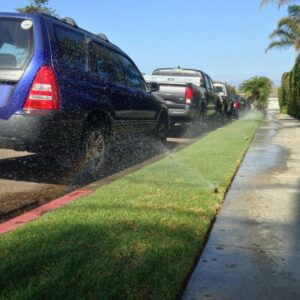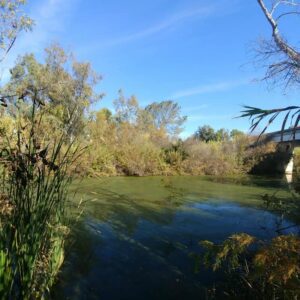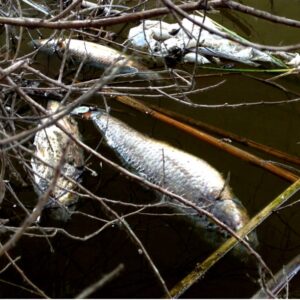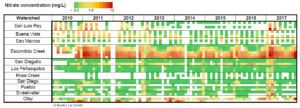As clean water people, we talk a lot about water quality here at Coastkeeper. Because we also care about where our water comes from and how much of it we are using, we also talk a lot about water supply and conservation. Below, we’ll take a deep dive into just how water quality and quality are connected, and explore the science behind how wasting water leads to increased pollution in our communities.
Urban Drool


Outdoor water use like watering your lawn, washing your car, and running sprinklers significantly affect our watersheds. Because water doesn’t know where your property line ends and a river or the ocean begins, the waterways downstream of your house (called “receiving waters”) are exposed to variety of stressors from the untreated runoff seeping out of our communities. Though a lot of runoff occurs all at once when it rains, most often that runoff is created not by big winter storms, but by what officials call “dry-weather flows,” “nuisance runoff,” or my personal favorite – “urban drool.” This is the wasted water from over-watered lawns, leaky pipes, hosing down driveways, and so on. This wasted-water-turned-urban-drool not only strains our water supply, but creates a convenient way for pollution to reach our local waterways. You know all that nitrogen your neighbor put on his lawn last weekend to keep the grass green? It’s now feeding a frenzy of algae growth in the San Diego River.
The Pollutants


Excessive nutrients like nitrogen and phosphorus found in fertilizers and detergents are major contributors to a condition called eutrophication in our rivers and streams.
Eutrophication occurs when naturally occurring algae are stimulated to bloom by excess nutrients in the water. Basically, we’re unintentionally over-feeding them with the fertilizer from our lawns and golf courses, and they are growing out of control. Dense algal blooms reduce water clarity, limit the amount of light that can penetrate the water, and choke narrow waterways with masses of algae. That’s just the beginning. When the overfed mass of algae eventually dies, it decomposes rapidly, creating bad odors and severely reducing dissolved oxygen levels. Dissolved oxygen (one of the things we measure in our water quality monitoring program), is necessary to sustain aquatic wildlife like fish. Without it, the fish die.
Let’s recap.
The extra water dumped on an over-watered lawn carries excess nutrients into our rivers and streams, where those nutrients stimulate crazy algae growth, which blocks out light and chokes waterways, and upon decomposing, smells terrible, looks bad, and kills a bunch of aquatic wildlife. Whew! Got it?
The Monitoring Program


Volunteers with San Diego Coastkeeper’s water quality monitoring program see all these impacts first hand. They have been measuring nutrient concentrations at fixed sites in local waterways since 2010. While many local streams see spikes in nutrient levels during the winter rainy season (see Box 1 below for a deep dive) when rainwater carries pollutants throughout our communities, several watersheds have sites that show consistently high nutrient levels regardless of the time of year. Our volunteers frequently witness the signs of eutrophication when they’re out collecting samples, such as seeing the slimy green or brown sheen of dense algal growth in the water, smelling their noxious odors, and even occasionally encountering fish kills on stream banks (from rapidly depleted oxygen levels).
How You Can Make a Difference
Recent research published in the Proceedings of the National Academy of Sciences shows that residential sources dominate nutrient inputs in urban watersheds. In fact, the study found that nitrogen loading from household lawn fertilizer exceeded the combined inputs from golf courses, parks, schools, and other non-residential vegetated areas. Check it out here.
So, upstream solutions, or individual practices that stop or limit the problems of urban runoff in the first place, are key to managing urban eutrophication. You can limit the excess water and nutrients running off your property with a few simple steps:
- Choose landscapes that need little or no fertilizers and water to thrive. Many native, drought tolerant plants are already adapted to low nutrient soils and the dry southern California climate, and as a bonus, provide habitat for native wildlife like birds and butterflies.
- For plants that need a little extra water, try compost or mulch to help your soil store water and replenish nutrients more slowly than chemical fertilizers.
- Use properly installed drip- or other water-efficient irrigation systems and check them frequently for breaks or leaks.
- Sweep debris from decks or driveways, rather than using a hose.
- Wash vehicles at a professional car wash, which recycles water, instead of washing them in your driveway.
And there you have it. Simple choices that will save you money on your water bill, and end up protecting the waterways and wildlife downstream.
Box 1. Eight years of nitrate concentrations in area streams as measured by San Diego Coastkeeper’s volunteer water quality monitoring program. Each square in the matrix represents one site by one month. Watersheds are arranged north to south, and within each watershed sites are arranged west (downstream) to east (upstream). Warmer colored squared indicate higher nitrate concentrations

















